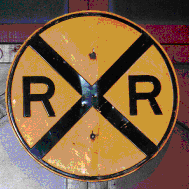
There are few places in Canada that were not affected by the railways. As the railways crossed the country new towns were created along the route. The towns in southern Alberta were created because of the railway, just like most other towns in Canada.

P19640265000-GM The coal sheds at Dunmore where coal was stored before it was sent off to market.
Very few people know that at one time there were different kinds of railway tracks. Today all rail companies in Canada and the United States use a “Standard Gauge Track”. A standard track is about 1.5 metres wide. The first railway tracks ever laid in Lethbridge were not “Standard Gauge Tracks” they were “Narrow Gauge Tracks”. This means that the train tracks that first came to Lethbridge were only one metre wide. The first line in Lethbridge went from Lethbridge to Dunmore, Alberta. This line was built by the Alberta Railway and Coal Company because they needed to move the coal they were mining from Lethbridge to the main Canadian Pacific line. They decided to use a “Narrow Gauge Track” over a “Standard Gauge Track” because it was much cheaper to build.

A railway crossing sign, this sign was a common sight to many on the prairies who came across a set of railway tracks.
This first narrow gauge line into Lethbridge was finished on August 28, 1885. The Alberta Railway and Coal Company, who built the rail line, was owned mostly by the Galt family. By 1890, the Alberta Railway and Coal Company had built a large rail network. The Galt family also owned many coal mines in the area and employed many people in the town of Lethbridge. Realizing new opportunities in the region, the Alberta Railway and Coal Company expanded their interests into irrigation. In doing so they joined the Alberta Railway and Coal Company with another company forming the Alberta Railway and Irrigation Company in 1904. This allowed the new company to better manage their railway and irrigation projects because they had more money to spend as a bigger company.

P19694968000-GP Dunmore Junction and station where the narrow gauge line met with the standard gauge track.
As time passed, the Alberta Railway and Irrigation Company built more rail lines to better meet the needs of their customers in the region. The network of rail lines came to be known as the Galt system because the main owner and manager of the AR &I Co. was Sir Alexander Galt and his son Elliot T. Galt. This system, which totaled some 595 kilometres of track, was completely changed from narrow gauge to standard gauge track by 1909.The change was done so that other rail cars traveling the main CPR line could also move around in the Galt system. These changes took eight years to complete.

A map from promotional material showing the rail network in southern Alberta in 1911.
While the Galts were changing their railway tracks, the Canadian Pacific Rail Company was working to expand their own system. The construction of the C.P.R. began in 1880 as part of Prime Minster MacDonald’s “National Policy”. His idea of “National Policy” was created to promote and unite Canada. Once the C.P.R. had completed construction of its main line in 1885, it began to take over and build “branch” lines to connect to the main line. The C.P.R. did not buy the Galt system until April of 1912. But when they did, the Galt system became an important part of the C.P.R. system. Smaller lines, such as the Galt system, had proven to be of great importance in creating the national dream of a truly transcontinental railway network.
 Native People
Native People Previous Page | Exhibit Contents | Home | Navigation Information | Glossary | Curriculum Guide | Next Page
Copyright © 1996 Sir Alexander Galt Museum. All rights reserved.